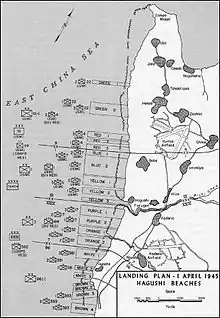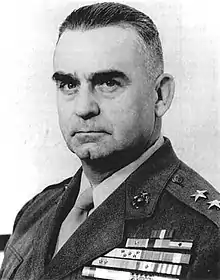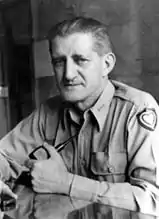Okinawa ground order of battle
The American invasion of the island of Okinawa, codenamed Operation Iceberg, took place 1 April 1945. The Japanese military was determined to inflate a casualty rate so high that the U.S. government would choose not to invade the Japanese home islands. To this end, the southern portion of the island had been covered with the most extensive system of fortifications and fields of fire yet encountered in the Pacific War.

The island was not declared secure until 22 June, a period of 82 days. Lieutenant General Simon Bolivar Buckner Jr. became the highest ranking U.S. military officer to be killed in action in the Second World War.
American forces







![]() US Tenth Army
US Tenth Army
Lieutenant General Simon Bolivar Buckner, USA (KIA 18 Jun)
Major General Roy S. Geiger, USMC (18 Jun thru 23 Jun)
General Joseph W. Stilwell, USA (from 23 Jun)
- Tactical Air Force, Tenth Army - MajGen Francis P. Mulcahy/MajGen Louis E. Woods
Northern Landing Beaches[1]
![]() III Amphibious Corps
III Amphibious Corps
Commanding general: Major General Roy S. Geiger, USMC
- Chief of Staff: Brigadier General Merwin H. Silverthorn, USMC
- Chief of Corps Artillery: Brigadier General David R. Nimmer, USMC
Embarked in Task Force 53
Left Beaches:
6th Marine Division (24,356 officers and enlisted)
- Division Commander: Major General Lemuel C. Shepherd, Jr., USMC
- Assistant Division Commander: Brigadier General William T. Clement, USMC
- 22nd Marine Regiment; C.O. Colonel Merlin F. Schneider, USMC – Green Beaches; then Colonel Harold C. Roberts
- 4th Marine Regiment; C.O. Colonel Alan Shapley, USMC – Red Beaches
- 29th Marine Regiment; C.O. Colonel Victor Bleasdale, USMC – Reserve; then Colonel William J. Whaling
- 15th Marine Regiment (Artillery); C.O. Colonel Robert B. Luckey, USMC
Right Beaches:
1st Marine Division (26,274 officers and enlisted)
- Division Commander: Major General Pedro A. del Valle, USMC
- Assistant Division Commander: Brigadier General Louis R. Jones, USMC
- 7th Marine Regiment; C.O. Colonel Edward W. Snedeker, USMC – Blue Beaches
- 5th Marine Regiment; C.O. Colonel John H. Griebel, USMC – Yellow Beaches
- 1st Marine Regiment; C.O. Colonel Arthur T. Mason, USMC – Reserve
- 11th Marine Regiment (Artillery); C.O. Colonel Wilburt S. Brown, USMC
1st Provisional Antiaircraft Artillery Group
- Commanding officer: Colonel Kenneth W. Benner, USMC
Southern Landing Beaches[2]
![]() XXIV Army Corps
XXIV Army Corps
Major General John R. Hodge, USA
Embarked in Task Force 55
Left Beaches:
7th Infantry ("Bayonet") Division (21,929 officers and enlisted)
- Division Commander: Major General Archibald V. Arnold, USA
- 17th Infantry Regiment – Purple Beaches
- 32nd Infantry Regiment – Orange Beaches
- 184th Infantry Regiment – Reserve
- Field Artillery Battalions, 105mm: 48th, 49th, 57th
- Field Artillery Battalions, 155mm: 31st
Right Beaches:
96th Infantry ("Deadeye") Division (22,330 officers and enlisted)
- Division Commander: Major General James L. Bradley, USA
- 381st Infantry Regiment – White Beaches
- 383rd Infantry Regiment – Brown Beaches
- 382nd Infantry Regiment – Reserve
- Field Artillery Battalions, 105mm: 361st, 362nd, 921st
- Field Artillery Battalions, 155mm: 363rd
Reserve:
27th Infantry ("New York") Division (16,143 officers and enlisted)
- Division Commander: Major General George W. Griner, Jr., USA
- 105th Infantry Regiment – landed L+8
- 106th Infantry Regiment – landed L+8
- 165th Infantry Regiment – landed L+8
- Field Artillery Battalions, 105mm: 104th, 105th, 249th
- Field Artillery Battalions, 155mm: 106th
Western Islands[3]
Ie Shima, etc.:
77th Infantry ("Statue of Liberty") Division (20,981 officers and enlisted)
Embarked in Task Group 51.1
- Division Commander: Major General Andrew D. Bruce, USA
- 306th Infantry Regiment – landed 17 Apr (Green Beach)
- 305th Infantry Regiment – landed 17 Apr (Red Beaches 1 & 2)
- 307th Infantry Regiment – landed 17 Apr (Red Beaches 3 & 4)
- Field Artillery Battalions, 105mm: 304th, 305th, 902nd
- Field Artillery Battalions, 155mm: 306th
- One Marine BLT
Japanese forces

Thirty-second Army[4][lower-alpha 1]
Lieutenant General Mitsuru Ushijima (seppuku 22 June)
Approx. 67,000 men under arms, incl. 5,000 Okinawan conscripts[5]
- 24th Division
- Lt. Gen. Tatsumi Amamiya (KIA 30 June)
- 22nd Infantry Regiment
- 32nd Infantry Regiment
- 89th Infantry Regiment
- 62nd Division
- Lt. Gen. Takeo Fujioka (suicide 22 June)
- 63rd Brigade
- 67th Brigade
- 44th Independent Mixed Brigade
- Maj. Gen. Suzuki Shigeji (died 22 June)
Notes
- A Japanese army was equivalent to a Euro-American corps.
References
- Rottman 2004, pp. 55, 91-92
- Rottman 2004, pp. 55, 90-91
- Rottman 2004, p. 91
- Rottman 2004, p. 93
- Rottman 2004, p. 50
Bibliography
- Rottman, Gordon (2004). Okinawa 1945: The Last Battle. Osprey. ISBN 0-275-98274-2.
| Wikimedia Commons has media related to Battle of Okinawa. |